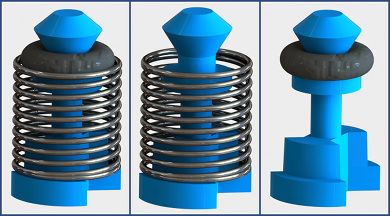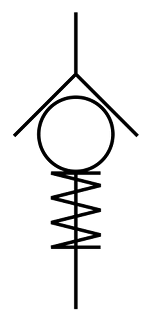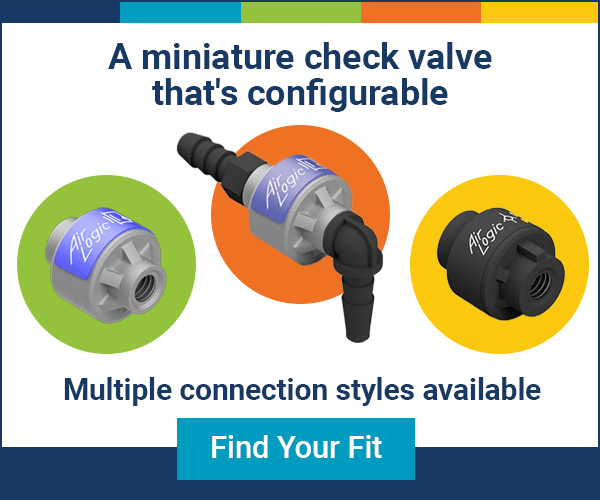Spring Loaded Check Valves – Check Valves Part III
 Spring loaded check valves are also commonly used
Spring loaded check valves are also commonly used
The first post in this series described check valves as valves that allow liquid or gas flow in only one direction. Like plastic diaphragm check valves, spring loaded check valves prevent reverse flow. Miniature in-line spring loaded check valves have particular qualities that make them appropriate in some air, gas and fluid flow control applications. In this post, I will review some basics of miniature in-line spring loaded check valves design and function plus a little about why spring loaded check valves are so useful and how they are used.
A quick review of check valve basics
Check valves are two-port valves with two openings in the valve body. One opening is for air, gas or fluid (the media) to enter the valve, the inlet port. The other opening in the valve is for the media to exit the valve, the exit port. Like all check valves, spring loaded check valves require no external control to work. Excluding the spring, spring loaded check valves possess the same basic design elements as all other check valves.
Spring loaded check valve uses and characteristics:
- Protect equipment from backflow damage
- Provide pressure relief for system safety
- Prevent contamination from reverse flow
- No human intervention is required to function
- Powered by flow and differential pressure with assistance from spring pressure
Spring loaded or spring assist
Spring loaded versus no spring represents a very basic divide in check valve types. Spring loaded means pretty much what you would think. The key benefit of building a spring into a check valve’s mechanism is that it largely eliminates the effect of gravity on check valve function. Without a spring, gravity and thus the valve’s vertical orientation can become a critical factor for a check valve to work properly.
Manufacturers make spring loaded check valves in a wide variety of connection types, cracking pressures and materials. More importantly, ISM is in the unique position of being able to add spring loaded check valve functionality to almost every fitting we offer. The metal springs in spring loaded check valves are made of stainless steel or some other highly corrosion resistant steel alloy. It is important to note that this type of check valve is usually designed to be normally closed.
Spring loaded check valve benefits
- Provides quick interruption of flow
- Provides positive sealing at pressures below the cracking pressure of the valve
- Does not require gravity or backflow pressure to work or actuate
- Provides positive valve closure regardless of vertical orientation
- Prevents system fluid or gas backflow during routine maintenance
- Springs can accommodate very wide temperature ranges
A reminder about what cracking pressure is
Cracking pressure is the minimum upstream pressure when a normally closed check valve begins to open and flow starts. It is possible to design very precise spring pressures and so it is usually possible to find miniature spring loaded check valves made with particular cracking pressures to meet specific application criteria.
Highly simplified and idealized spring loaded check valve design and operation
A miniature spring loaded check valve is usually installed in-line with the process piping. The valve body is hollow. This body has a cross-sectional element, the seat, with a passage or hole through it. This passage is oriented across the flow through the valve.
The check valve seat divides the valve into upstream (inlet) and downstream (outlet) sides. An oversized stopper of some sort rests inside the valve and can move so that one of its surfaces, the sealing surface, can rest against the valve seat. The spring’s position applies a constant pressure holding the valve sealing surfaces together.

Figure 8 – spring loaded check valve Poppet shaped plunger with an O-ring seal
A check valve ‘stopper’ or ‘plunger’ is usually shaped like a ball, disc, piston or poppet (see figure 8 above). This illustration shows a generic spring loaded check valve poppet. It also has an O-ring seal enhanced sealing surface.
Fluid or gas flow in the correct direction and at the right pressure (the downstream pressure) overcomes the force of the spring and pushes the sealing surface of the plunger away from the seat. This allows flow to take place. When the upstream pressure drops low enough, the spring pushes the sealing surface of the stopper back against the sealing surface of the valve seat, which closes the valve and prevents reverse flow.

A reminder about check valve installation
Because check valves provide one-way flow, it is important to install them in the correct linear orientation. An arrow or the symbol for any type of check valve (a fluidic/pneumatic logic symbol) on the outside of the body indicates flow direction. In this image, flow is from top to bottom. Some check valves will have both the logic symbol and an arrow to indicate correct orientation.
Technical specifications that matter for spring loaded check valves
- Materials (chemical compatibility)
- Minimum cracking pressure
- How quickly the check valve closes
- End connection options
- Pressure drop across the valve when completely open
Other considerations
- Operating environment
- Operating temperatures
- The type of gasses or liquids (media) being used
- Media viscosity
- Flow conditions such as low flow or low pressure
Conclusion
This description of spring loaded check valves provides some reasons as to why they are so widely used. They can be selected without worrying about the effects of vertical orientation because of their springs. Precisely engineered spring forces provide a range of check valve cracking pressures, helpful when matching them to application specifications. They also close before flow has completely stopped instead of relying on reverse-flow pressure to close completely.
Look for our next blog article when we will review some of the basic design features of precision orifices and why they are so useful:
An Introduction to Orifices and Their Applications
Have you had trouble choosing the right spring loaded check valve for one of your projects? Did low flow or low-pressure conditions cause problems? How about corrosion resistance or media temperature? Help us by telling others about what you learned.
Have questions about check valve features or function? If so, send me an email – steven.williams@industrialspec.com. You can also ask questions using the comments section below.
You also might want to take a look at our previous posts about check valves:

